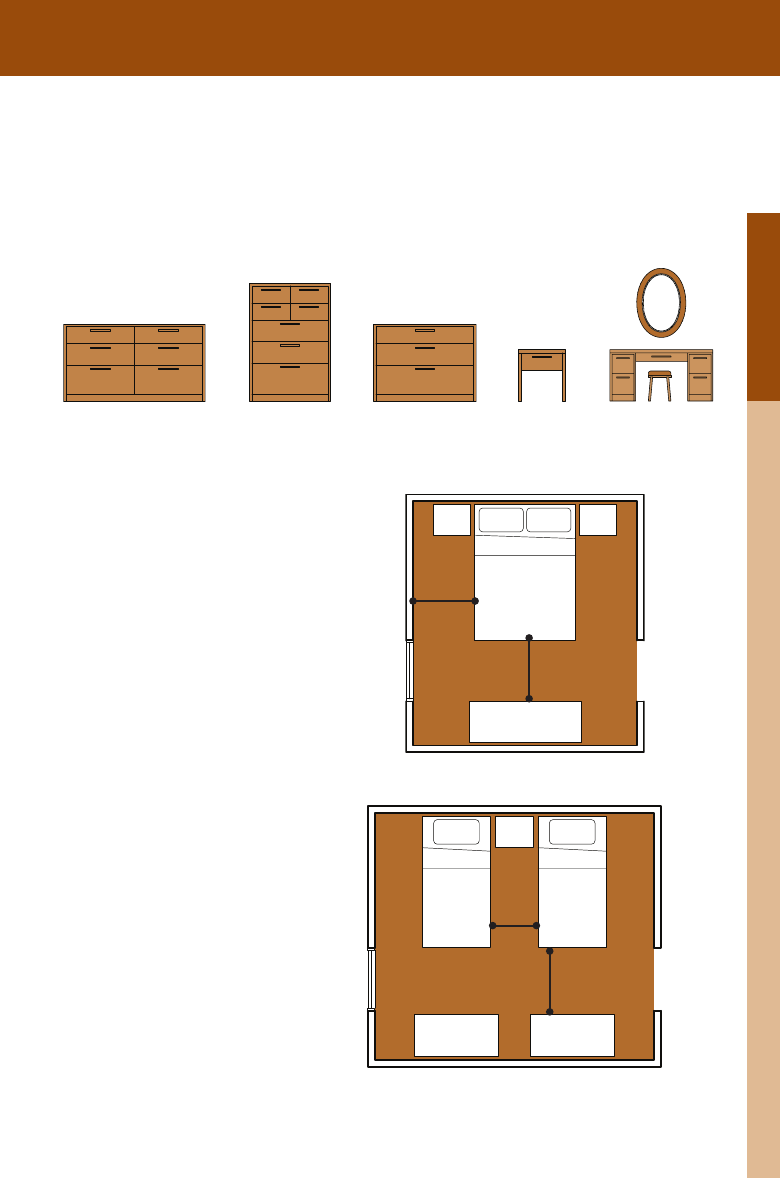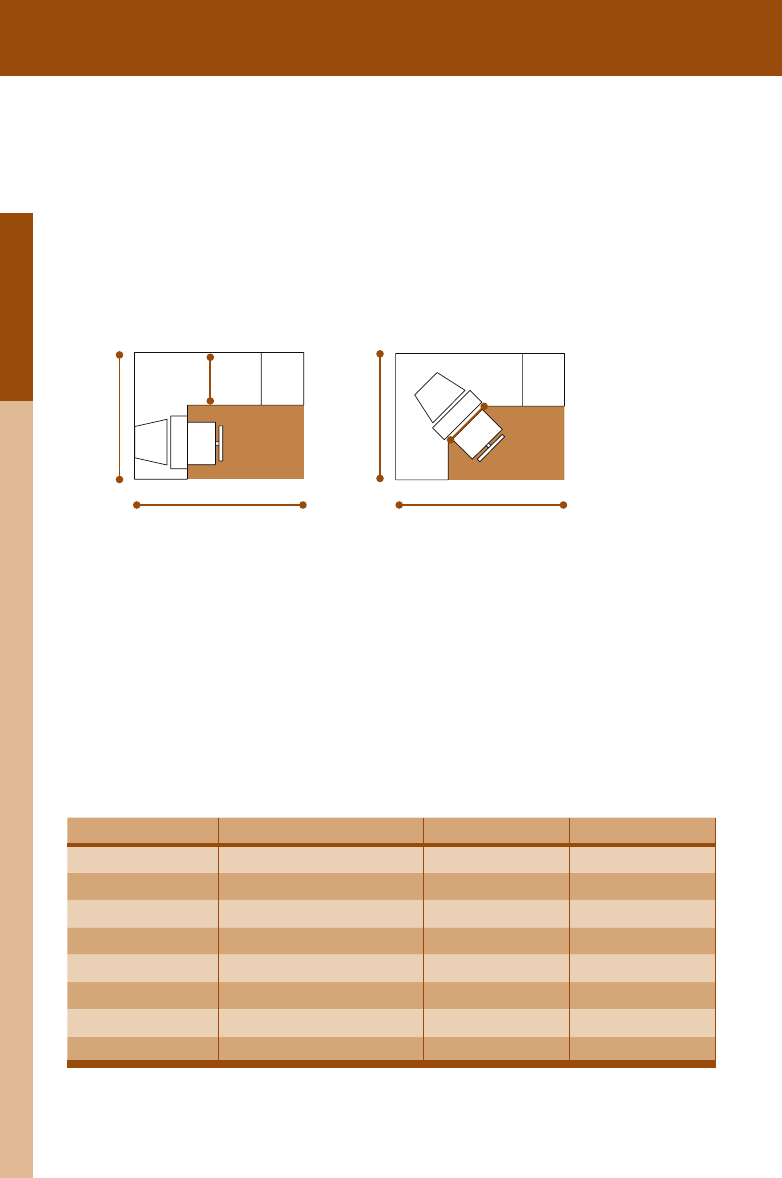
07
Job:02-30056 Title: RP-Interior Design Reference and Specification
#175 Dtp:216 Page:102
(RAY)
092-111_30056.indd 102 3/4/13 7:33 PM
102
THE INTERIOR DESIGN REFERENCE + SPECIFICATION BOOK
Text
BEDROOMS
The most important goal in designing a bedroom is to establish a comfortable relationship
between the occupants and their bed and between the bed and the room at large. Because
people spend an average of six to eight hours a day in the bedroom, the space must engender
feelings both of relaxation and security. The design of bedrooms should also accommodate
activities such as reading and functions such as storage for personal belongings.
Furniture
Beds
The bed is the only indispensable piece of furniture
in the bedroom; many other functional require-
ments can be accommodated by built-in furniture.
Examples include built-in window seats and closets.
The standard dimensions for beds below will be
helpful when selecting the right size bed for a
specic room.
Crib
Twin Twin XL
Full Full XL
Queen King
Twin Beds in a Room
A minimum of
between beds is recommended; this al-
lows for a shared night table and ample
room to get into and out of bed.
Additional Furniture
Depending on the size of the room, bedside tables, lounge chairs, side tables, and even
writing desks can be added to a bedroom to promote quiet activities during waking hours. Aug-
menting built-in closets, pieces such as dressers, armoires, and vanities provide other forms
of storage in larger rooms.
Bedroom Layouts
Bed Centered in Room
The most typical and practical congura-
tion is to place the bed in the center of the
room against one wall. The dimensions
recommended below provide ample space
for two people to get into and out of bed.
STANDARD DIMENSIONS
Type Inches Millimeters
Crib
24 × 54 610 × 1 372
Twin
39 × 75 990 × 1 905
Twin XL
39 × 75 990 × 2 134
Full
54 × 75 1 372 × 1 905
Full XL
54 × 84 1 372 × 2 134
Queen
60 × 84 1 524 × 2 134
King
76 × 84 1 930 × 2 134
Job:02-30056 Title: RP-Interior Design Reference and Specification
#175 Dtp:216 Page:102
(RAY)
092-111_30056.indd 102 3/4/13 7:33 PM

07
Job:02-30056 Title: RP-Interior Design Reference and Specification
#175 Dtp:216 Page:103
Job:02-30056 Title: RP-Interior Design Reference and Specification
#175 Dtp:216 Page:102
(RAY)
092-111_30056.indd 103 3/4/13 7:33 PM
103
Types of Rooms
Text
people spend an average of six to eight hours a day in the bedroom, the space must engender
Twin Beds in a Room
A minimum of 30 inches (762 millimeters)
between beds is recommended; this al-
lows for a shared night table and ample
room to get into and out of bed.
Additional Furniture
Depending on the size of the room, bedside tables, lounge chairs, side tables, and even
writing desks can be added to a bedroom to promote quiet activities during waking hours. Aug-
menting built-in closets, pieces such as dressers, armoires, and vanities provide other forms
of storage in larger rooms.
Bedroom Layouts
Bed Centered in Room
The most typical and practical congura-
tion is to place the bed in the center of the
room against one wall. The dimensions
recommended below provide ample space
for two people to get into and out of bed.
24"–36"
(610–914)
30"–36"
(762–914)
30"–36"
(762–914)
30"–36"
(762–914)
Job:02-30056 Title: RP-Interior Design Reference and Specification
#175 Dtp:216 Page:103
Job:02-30056 Title: RP-Interior Design Reference and Specification
#175 Dtp:216 Page:102
(RAY)
092-111_30056.indd 103 3/4/13 7:33 PM

07
Job:02-30056 Title: RP-Interior Design Reference and Specification
#175 Dtp:216 Page:104
(RAY)
092-111_30056.indd 104 3/4/13 7:33 PM
10 4
THE INTERIOR DESIGN REFERENCE + SPECIFICATION BOOK
Text
BATHROOMS
Options for bathroom congurations range from two-xture powder rooms to ve-xture master
bathroom suites. The diagrams below include the average sizes for bathrooms based on the
number and position of xtures. For all bathroom layouts, comfort and privacy are top priorities.
Ba thr o o m La yo uts
Powder Rooms Typical Bathroom
2'-6" (762)
6'-3" (1 905)
4'-6" (1 372)
4'-0" (1 219)
7'-0" (2 134)
5'-0" (1 524)
Ideal Two-Person Bathroom
11'-6" (3 505) +/-
60" (1 524)36" (914)
6'-0" (1 829)
Four-Fixture Bathroom Five-Fixture Bathroom
11'-6" (3 505) min.8'-6" (2 591)
7'-0" (2 134)
8‘-6" (2 591)
Design Considera tions
Two-Person Use
Placing lavatory, bath, and toilet in a single space is not ideal when the bathroom is shared.
When two people commonly use a bathroom suite at the same time, an enclosed toilet or a
separate toilet room should be considered if space allows.
Wall and Floor Finishes
Numerous options are available for oor and wall nishes for a bathroom, from ceramic tile to
glass tile to stone. Wall nishes need to be water-resistant with a waterproof substrate to
inches (
Lighting
Bathrooms should include both general room lighting and task lighting at the mirror and over
the shower. The best mirror lighting is at the sides via wall sconces, which prevents shadows
on the face. Wall sconces should be placed approximately
the oor and minimally
as the sole source of light. If the bathroom is too small and there is not enough room for side
lighting, consider introducing a light cove above the mirror.
Shower Controls
The many recent advances in shower design can make the selection of shower controls con-
fusing. Here basic elements are dened:
Spray Showerhead:
of a tub-shower combination. Mounted to the wall, it comes in a variety of spray patterns.
Supplemental hand-held showers allow for more exibility.
Shower Diverter:
A two-way diverter is for a bathtub and shower combination. These diverters can be as simple
as a pull-tab on the tub spout that redirects the water ow from one function to the other.
A three-way diverter, which redirects the water ow among tub, showerhead, and hand-held
shower, is a separate control value mounted on the wall.
Thermostatic-controlled Valve:
ling the amount of water coming through the system at a precise temperature.
High-ow Valve:
this end of the spectrum, the various manufacturers offer many features that are unique to
their system.
30" (762)
Job:02-30056 Title: RP-Interior Design Reference and Specification
#175 Dtp:216 Page:104
(RAY)
092-111_30056.indd 104 3/4/13 7:33 PM

07
Job:02-30056 Title: RP-Interior Design Reference and Specification
#175 Dtp:216 Page:105
Job:02-30056 Title: RP-Interior Design Reference and Specification
#175 Dtp:216 Page:104
(RAY)
092-111_30056.indd 105 3/4/13 7:33 PM
10 5
Types of Rooms
Text
Options for bathroom congurations range from two-xture powder rooms to ve-xture master
number and position of xtures. For all bathroom layouts, comfort and privacy are top priorities.
5'-0" (1 524)
8‘-6" (2 591)
Design Considerations
Two-Person Use
Placing lavatory, bath, and toilet in a single space is not ideal when the bathroom is shared.
When two people commonly use a bathroom suite at the same time, an enclosed toilet or a
separate toilet room should be considered if space allows.
Wall and Floor Finishes
Numerous options are available for oor and wall nishes for a bathroom, from ceramic tile to
glass tile to stone. Wall nishes need to be water-resistant with a waterproof substrate to 72
inches (1 829 millimeters) above nish oor and oors need to be slip-resistant.
Lighting
Bathrooms should include both general room lighting and task lighting at the mirror and over
the shower. The best mirror lighting is at the sides via wall sconces, which prevents shadows
on the face. Wall sconces should be placed approximately 66 inches (1 676 millimeters) above
the oor and minimally 30 inches (762 millimeters) apart. Avoid using ceiling-mounted xtures
as the sole source of light. If the bathroom is too small and there is not enough room for side
lighting, consider introducing a light cove above the mirror.
Shower Controls
The many recent advances in shower design can make the selection of shower controls con-
fusing. Here basic elements are dened:
Spray Showerhead: Traditional showerhead that can be used in a shower enclosure or as part
of a tub-shower combination. Mounted to the wall, it comes in a variety of spray patterns.
Supplemental hand-held showers allow for more exibility.
Shower Diverter: Valve that redirects water from a spout to a showerhead or hand-held shower.
A two-way diverter is for a bathtub and shower combination. These diverters can be as simple
as a pull-tab on the tub spout that redirects the water ow from one function to the other.
A three-way diverter, which redirects the water ow among tub, showerhead, and hand-held
shower, is a separate control value mounted on the wall.
Thermostatic-controlled Valve: Valve that allows the water temperature to be set, while control-
ling the amount of water coming through the system at a precise temperature.
High-ow Valve: Valve that controls custom designed showers with multiple spray heads. At
this end of the spectrum, the various manufacturers offer many features that are unique to
their system.
Job:02-30056 Title: RP-Interior Design Reference and Specification
#175 Dtp:216 Page:105
Job:02-30056 Title: RP-Interior Design Reference and Specification
#175 Dtp:216 Page:104
(RAY)
092-111_30056.indd 105 3/4/13 7:33 PM

07
Job:02-30056 Title: RP-Interior Design Reference and Specification
#175 Dtp:216 Page:106
(RAY)
092-111_30056.indd 106 3/4/13 7:33 PM
10 6
THE INTERIOR DESIGN REFERENCE + SPECIFICATION BOOK
Text
OFFICE ENVIRONMENTS
Dimensional Criteria
A workstation has three basic components: a task surface for writing or spreading materials,
an area for the computer, and ling cabinets for storing ofce materials and personal belong-
ings. Below are generic dimensions for a workstation that can be modied to t the needs of
specic users.
Types of Files
Files are available in two basic types: lateral or pedestal. Lateral les open on the wide end,
and their drawers extend the width of a letter, legal, or ledger le folder. Pedestals les open
from the narrow end and thus need extra room in front of the drawer to allow a full extension
into the open position. When specifying ve-drawer les, it is better to choose lateral les for
easier access to materials in the top drawer. The table below is a general guide to le sizes;
note that each manufacturer has specic dimensions for their les.
8'-0" (2 438)
5'-6" (1 676)
30"
(762)
32"
(813)
Freestanding Furniture
Freestanding furniture does not require
panels or partitions to make different
congurations of workstations
Panel-Based Systems
Panel-based systems dene worksta-
tion boundaries with low partitions.
Horizontal surfaces, les, and storage
units are attached to the panels to
complete the workstation.
Table-Based Systems
Table-based systems are suited to
collaborative environments where
interaction with colleagues is required.
Depending on the system design, les
and storage units can be placed under-
neath or alongside the table.
Furniture Systems
Whether incorporated into a private ofce or into an open plan, modular furniture offers ex-
ibility for an ofce environment. There are three basic types of modular furniture systems:
freestanding, panel-based, or table-based. Each type of design incorporates features needed
at a workstation, such as hinged grommets, cable troughs, adjustable legs, and tackable
surfaces.
5'-6" (1 676)
8'-0" (2 438)
STANDARD DIMENSIONS
W D H
2-drawer Lateral
30", 36", 42" (762, 914, 1 067) 18" (457) 28" (711)
3-drawer Lateral
30", 36", 42" (762, 914, 1 067) 18" (457) 40" (1 016)
4-drawer Lateral
30", 36", 42" (762, 914, 1 067) 18" (457) 52" (1 321)
5-drawer Lateral
30", 36", 42" (762, 914, 1 067) 18" (457) 66" (1 676)
2-drawer Pedestal
15", 18" (381, 457) 30" (762) 28" (711)
3-drawer Pedestal
15", 18" (381, 457) 30" (762) 40" (1 016)
4-drawer Pedestal
15", 18" (381, 457) 30" (762) 52" (1 321)
5-drawer Pedestal
15", 18" (381, 457) 30" (762) 66" (1 676)
Job:02-30056 Title: RP-Interior Design Reference and Specification
#175 Dtp:216 Page:106
(RAY)
092-111_30056.indd 106 3/4/13 7:33 PM
..................Content has been hidden....................
You can't read the all page of ebook, please click here login for view all page.
